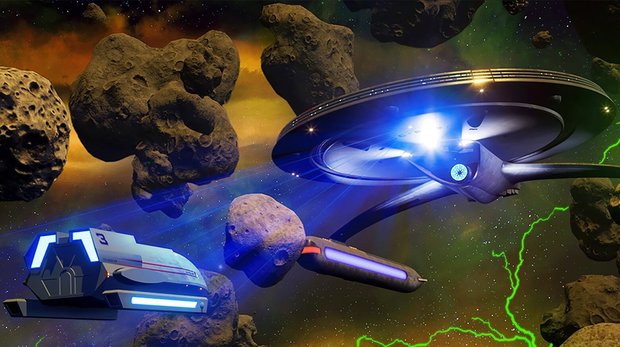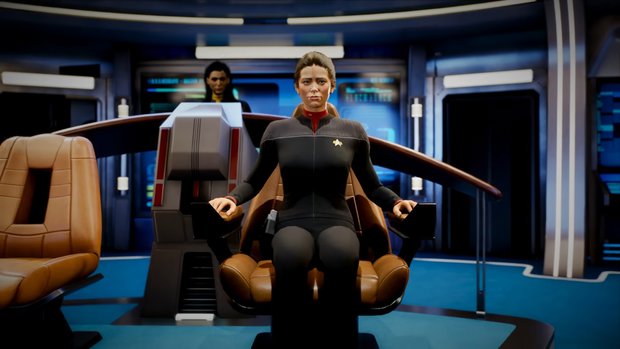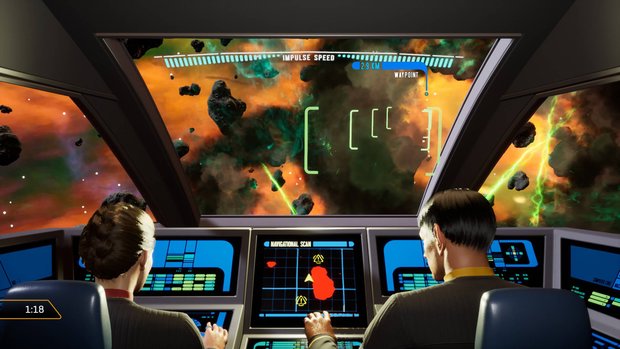Star Trek: Resurgence review

- 1 Comment
A treat for franchise fans that boldly goes where Telltale has gone before
Stardate 2023.143: It’s been a hot minute since Trekkies have been graced with a commercial adventure game. Twenty-seven years to be exact. In the meantime there have been endless action, strategy, RPG, and even pinball games based on the Star Trek franchise. Given that Trek is quite famously known for being light on action and heavy on diplomacy, it’s sad that adventure gamers have been left at spacedock for so long. But at long last the team at Dramatic Labs (made up of many former Telltale employees) have remedied this with the release of their first game, Star Trek: Resurgence. While there’s little in the way of puzzles and the interactivity can be painfully light at times, the good news is that the atmosphere and story are pure Trek and should entertain any fan of the franchise.
Taking place shortly after the events of Star Trek: Nemesis (and four years after the conclusion of Deep Space Nine), the game opens as the U.S.S. Resolute, a science vessel, is about to leave dock with their new first officer, a half-human, half-Kobliad named Jara Rydek. She was handpicked by Captain Solano, likely in part because she wasn’t a member of the crew that witnessed a mistake by their captain that cost many lives. For half of the game, you will guide Rydek through building rapport with the crew, evaluating and carrying out orders from the captain, and leading away missions.
The other character you will split time with is crewman Carter Diaz, an engineer from the lower decks who’s just hoping to do a good job and impress his Vulcan supervisor. Along with his colleague Edsilar (an unjoined Trill), his first task involves suiting up and making some repairs on the outside of the hull, which naturally doesn’t go as planned, forcing both he and Rydek to make critical decisions to save the ship.

The Resolute’s primary mission is to negotiate peace talks between the Alydians and the Hotari, species new to the Trek universe. The former is the more technologically powerful species, but the latter has the profitable mines and labor they’re dependent on and exploiting. Joining the crew is renowned negotiator Ambassador Spock, who will support Rydek and occasionally challenge Captain Solano. Predictably, peace talks quickly break down while Rydek and the crew uncover a terrifying horror that threatens the survival of not just the Federation, but the galaxy itself. Another intriguing alien race that had a one-off episode on The Next Generation will play a significant role. Given that Trek is notorious for alien-of-the-week episodes, it’s a welcome surprise to take a deeper dive into one of them.
As both Rydek and Diaz, the primary challenge will be navigating tough conversations. In some cases you will be making stressful command decisions, and in others you’ll be exercising your skills at diplomacy. Either way, your choices often affect how various crew members and characters feel about you. When this occurs, the game will immediately alert you with the result, illustrated with a picture of them showing approval, anger, or neutrality. You can then access the menu to read a fuller description of why the character reacted this way.
On a few occasions, this impacts how certain parts of the story play out (including the ultimate fates of some of the characters), though there is no way to prematurely end the game or drastically alter the story. Some actions will anger one character, yet please another. And frequently you are forced to decide whether or not to stay strong in your convictions or keep the peace. There are no wrong answers, and you can feel free to decide what makes sense to you. My approach while playing was, “What would Jean-Luc Picard do?” and I found the results to be pretty satisfying. My favorite part of conversations was employing empathy and understanding of other cultures to inform my decisions.

For those pining for action there are ample opportunities, during predetermined scenes, to use stealth or your phaser to bypass enemies. Phaser battles are limited in that you can’t freely move around. However, there is still plenty to do. You have to decide when to take cover, aim your weapon, and fire strategically at enemies who present a more imminent threat. The game is fairly forgiving in these areas, though I did fail several times. If you should die in the line of duty, you will be revived at the beginning of the scene to try again. And if a particular area is giving you fits, after failing the first time you will have an opportunity to temporarily switch to story mode. You will still take part in the scene, though you will be essentially invincible and can play at ease.
Play control is fairly intuitive via gamepad or mouse and keyboard. The former is a bit better for moving around in a 360-degree environment, though keyboard users should be just fine as you’re never given more than a room or two to explore at one time and precise movement is never necessary. Quick Time Events are also used sparingly in action scenes, often to dodge an attack or disarm your foe. Ample time is given for each event and serves mostly as a way to (successfully) increase adrenaline. Not only are there very few puzzles, those that exist are fairly dull and needlessly extend scenes in an already long adventure. They are essentially to-do lists; none are difficult and mostly just require using your tricorder to scan for biological or chemical irregularities. The most egregious example is when Rydek must traverse a room equipped with motion sensors that extend only in straight lines. Never mind the fact that the motion sensor on my home security system is a hundred times more effective, there is simply nothing interesting about ducking under and maneuvering between lasers.

The atmosphere is consistently engaging from beginning to end; it never doesn’t feel like you’re in the Star Trek universe. Franchise fans will feel at home with the ambient hum of the warp drive, the claustrophobic turboshafts, the colorful computer consoles, and the ominous thump of deployed photon torpedoes. There are also plenty of familiar yet relatively mundane activities you’ll be undertaking, such as using the transporter, analyzing readings with your tricorder, and piloting a shuttlecraft. These mostly require following simple directions, though the shuttlecraft flights require some basic maneuvering skill and can be failed if you’re not careful. Most of the time, character or plot development is happening concurrently, giving the tasks meaning while immersing you in the story. My only wish is that there was more freedom to explore the ship. At times it feels like you’re watching a television show, knowing that the director only has access to a few sets at a time.
Likewise hampering immersion are fairly modest character models that feel like they belong in a game from fifteen years ago. Facial movements are minimal; when characters spoke I sometimes found myself distracted by their lack of expression. They tend to walk stiffly as well. To top it off, the lip syncing is inconsistent. On the flip side, the cinematography is above average, with many detailed panoramic shots that bring home the scale of both the ship and the infinite void beyond.
You will visit other ships and alien planets along the way, including the Hotari mining colony, Alydian vessels, and an ice planet. While they are colorful and detailed, their scope is unnecessarily limited to familiar humanoid environments. The gravity is the same in every location. The tricorder recognizes pretty much everything. And the alien technology, while in a different language, is familiar enough to Diaz that he easily tackles it even under extreme duress.
The voice acting is a treat. Piotr Michael absolutely kills as Ambassador Spock. Had I not known that Leonard Nimoy is dead, I would have been none the wiser. Krizia Bajor also shines as Rydek, despite the writers giving her little room for joy or levity. Fans will also be delighted by a cameo from a beloved Trek veteran from The Next Generation. The music doesn’t quite reach the symphonic heights of a Jerry Goldsmith arrangement, but is nevertheless beautiful and very well-integrated into each scene, with only a few rare moments where it drowns out some dialogue.
The farther I progressed in the game, the less bothered I was by any of its faults. The nicely layered plot kept me riveted and the action heats up the closer you get to the finale. While some may argue there are too many back-to-back climaxes, they all feel genuine and rewarding. The final big scene is exceptionally scripted, with rapid changes between Rydek and Diaz as they desperately try to save the galaxy. But while I was wholly satisfied with the story’s ending, the denouement left me a bit cold. There’s virtually no resolution to the relationship choices you’ve made along the way, and several questions are left perplexingly unanswered, especially since there’s neither a cliffhanger nor a hint of a potential sequel. None of the alternate endings appear to fill in the blanks, offering just a few changes in character outcomes with different lines of dialogue.
While I have no strong desire to replay the game, I may have considered going back through various chapters to see how other command decisions played out. Alas, there is no chapter select available, and the only way to see a different permutation of the story is to log another ten or so hours to start again from the beginning, with no way to even speed through things you’ve already seen. You can log into the game’s website and use an in-game code to compare the decisions you made with the rest of the world’s players, though the statistics are not as comprehensive as with many similar games.
Final Verdict
I hesitate to recommend Resurgence to non-Star Trek fans. So much of my enjoyment came from losing myself in a universe I carry a deep love and nostalgia for. While the complex story holds its own and would be a worthy entry into the official canon, the script itself is a bit low on pathos. A really good episode of Trek would leave me laughing or crying or feeling deeply philosophical about human nature. There are definite attempts to reach those heights here as well, but the story beats don’t always land. So unless you’re a huge fan of sci-fi and/or solving problems via diplomacy, you may find yourself less enthralled without prior familiarity with this universe. That said, the atmosphere and story-building are impressive by any measure, and for existing fans this should be a no-brainer. If you’ve been patiently and agonizingly waiting three decades for a Trek adventure game, Resurgence is sure to have you beaming.
Hot take
While non-Trekkies and puzzle lovers may find Star Trek: Resurgence less appealing, franchise fans looking to simply dive into another fine story in this expansive universe will not be disappointed.
Pros
- Every inch of the game oozes Trek and would slide neatly into canon
- Intricate, original story is well-paced with plenty of thrills
- Tough diplomatic choices matter to the narrative
- Spock is expertly written and his voice perfectly mimicked
Cons
- The few puzzles that exist are mostly unimaginative and irrelevant
- Character models are stiff and lip-syncing is occasionally off
- The denouement is a bit of a letdown
- Some of the game’s highlights will be meaningless to non-Trek fans
Beau played Star Trek: Resurgence on PC using a review code provided by the game's publisher.










1 Comment
Want to join the discussion? Leave a comment as guest, sign in or register in our forums.
Ooh! I can't wait to play this. Thank you for the great review. I am definitely going to download this one and try it out... I'm always hoping there will be more classic "inventory" style puzzles in these newer hybrid-style adventures but it doesn't look like that's the case here in the most traditional-sense. Having never played many of the Telltale games, this particular title seems like such a great way to experience what they're all about. LOVE STARTREK!!!
Reply
Leave a comment